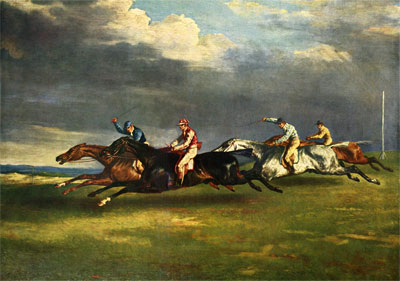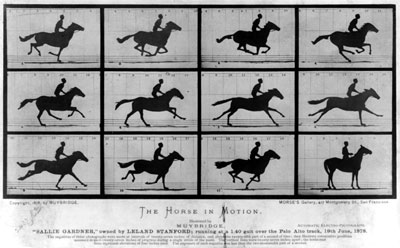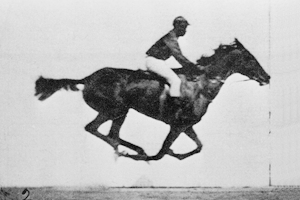Settle an argument in 1 second
 Prior to the late 19th century, most pictures of galloping horses showed the horse with both of their front legs extended forward and both their hind legs extended to the rear. To our eyes today those pictures look old-fashioned, but to most of the people of the day, that was how they thought a horse galloped. They didn’t know any better. That was until a man called Eadweard Muybridge proved otherwise.
Prior to the late 19th century, most pictures of galloping horses showed the horse with both of their front legs extended forward and both their hind legs extended to the rear. To our eyes today those pictures look old-fashioned, but to most of the people of the day, that was how they thought a horse galloped. They didn’t know any better. That was until a man called Eadweard Muybridge proved otherwise.
Muybridge, born Edward James Muggeridge on 9th April 1830 (whose 182nd birthday was celebrated recently on Google’s home page with an animation of a horse galloping), was an English photographer known for his pioneering work showing how animals run by using multiple cameras to capture motion. He famously invented the Zoopraxiscope, a device for projecting motion pictures that predated perforated film strip still used in cinematography.
It seems that Muybridge had a bit of an identity crisis as he changed his names several times in his career only settling on the name Eadweard Muybridge in the 1870s when he became more widely known for his work with Leland Stanford, an American businessman and race-horse owner. Stanford asserted that all four of a horse’s hooves are off the ground at the same time during the trot and took it upon himself, with Muybridge’s help, to prove it scientifically.

Muybridge arranged a series of large glass-plated cameras in a line, each one connected to a thread stretched across the path a horse would run through. As each thread was passed by the horse’s front legs, it triggered the camera’s shutter and took a photograph. The photos were copied onto a disc as silhouettes and viewed in Muybridge’s Zoopraxiscope. Later, in another series of photographs taken called The Horse in Motion, Muybridge showed how a horse gallops and is airborne, not with fore and hind legs off of the ground and fully extended as illustrated in the day, but rather when all the hooves are tucked under the horse as it switches between pulling with the front legs to pushing with the back legs.

So Eadward Muybridge, despite the change of spelling of his name, proved he was no Mug(geridge)! The series of photos Muybridge captured and displayed in his Zoopraxiscope are one of the earliest forms of videography. Muybridge’s moving images settled the argument about how a horse gallops in just 11 images displayed in a sequence which took less than one second to capture. A single still image can tell a story, but a series of still images, displayed in a sequence, can tell you more of the story.
Muybridge’s series of still images explained to the people of the day and told the true story about how a horse gallops. Today’s video cameras capture 25 still images per second (or 30 if you are in the USA). Video is the perfect method for telling a story and is being used increasingly by businesses today to tell true stories about their products or services. It works especially well when that story is difficult to explain or understand (as with Muybridge’s, The Horse in Motion), or when people want to see in action what you can do for them rather than have it told to them in words or single pictures.
You can see some examples below. Muybridge helped to settle the argument about how a horse gallops in less than one second – although it took him several years to perfect his invention to do it.
Today, using video, you have the opportunity to tell the story about your business’s products and services and demonstrate what you do in a clear and concise way too. You will need more than a second of video to do so, but between 30 seconds and 2 minutes should be ideal
It’s true that a picture is worth a thousand words. But how many more is a video worth?
